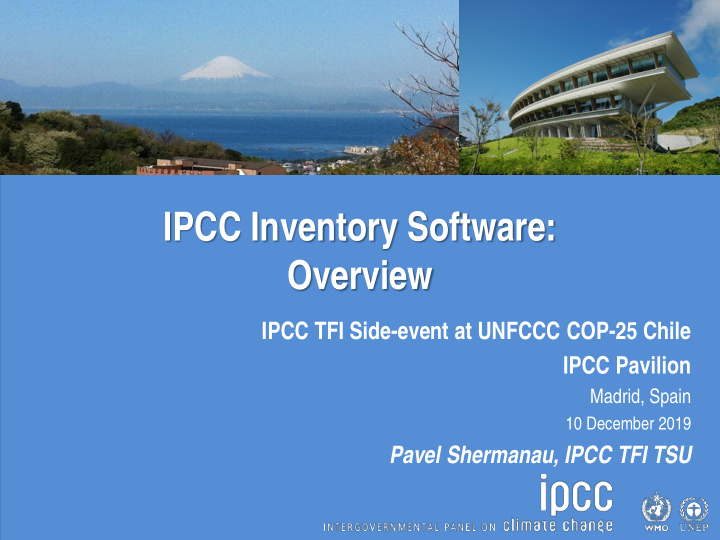



IPCC Inventory Software: Overview IPCC TFI Side-event at UNFCCC COP-25 Chile IPCC Pavilion Madrid, Spain 10 December 2019 Pavel Shermanau, IPCC TFI TSU
Outline o Background o Status o Plans
Background o IPCC Inventory Software is one of the products of the IPCC Task Force on National Greenhouse Gas Inventories (IPCC TFI) together with Methodology reports, EFDB and others o The software implements the 2006 IPCC Guidelines for National Greenhouse Gas Inventories ( 2006 IPCC Guidelines ) o Originally only Tier 1 Worksheets of the 2006 IPCC Guidelines were implemented o The software was launched in 2012. The latest version published is Version 2.69, which was released on October, 25, 2019
Background o The software can be downloaded from IPCC TFI web-site (for free): http://www.ipcc-nggip.iges.or.jp/software/index.html , and it comes in .exe file of 42.5 MB to be installed o It runs on Windows Microsoft OS only o The database is password protected and a hint to recover the password is to be provided (otherwise, once the password lost, the database cannot be recovered by a user) o Non-English User Manual is available in addition to the official English version: • French version (translated by Government of Belgium) • Arabic version (translated by Sidati Ould Dah Ould EIDA, CCPNCC, Mauritania)
Main menu Category: Energy Data Entry Hierarchical list of categories Worksheet-based calculations follow Time Series 2006 Guidelines Status bar contains Display useful information e.g. country, inventory year 5
Software Functions Administration functions: Country, Users, QA/QC: Years Uncertainty Contains default analysis, KCA, data Reference method Worksheets for data entry Data Managers : Data Export Land Types and and Livestock Import Data Archive
An Example - Export
Status The IPCC Inventory Software aims to assist inventory compilers in using the IPCC Guidelines: o it can be used for the whole inventory or just individual categories, allows different sectors of the inventory to be developed simultaneously, provides default data from the 2006 IPCC Guidelines , but gives users the flexibility to use their own country-specific information o it can be used when reporting outputs in non-Annex I National Communications format (reporting tables, consistent with Tables 1 and 2 in Annex to Decision 17/CP.8) o although it was designed to implement Tier 1 methods and to follow the Worksheets of the 2006 IPCC Guidelines , the latest version 2.69 allows to perform Tier 2 for majority of categories in Energy, IPPU, Waste and Agriculture
Multiple Users Project manager Sectoral Expert(s) Distribute updated DB Distribute empty database (MDB file) (MDB file) Compile Sector 1 PM: Initialise PM: Update Database Database Compile Sector 2 Combine Databases Combine Databases (XML File) (XML File) Compile Sector n Database Checks, Using XML file will reduce Uncertainty, KCA the chances of losing or overwriting the database unintentionally Prepare Outputs
Usage of IPCC Inventory Software by countries STATISTICS FROM 60 DEVELOPING COUNTRIES SAMPLED FROM THE UNFCCC TRAINING WORKSHOPS ON NGHGI (QUESTIONNAIRE) Use IPCC software for preparing GHG estimate Do not make any use (around 60%) of the IPCC … Use IPCC software for QC (around 5%) Use Excel-based Software for Revised 1996 Guidelines (10%)
Plans (subject to resource availability) IPCC TFI is planning to implement the following: o Implementation of all Tier 2 methods for all sectors. Currently the work is going on AFOLU Sector (3C by February (Beta version) then 3 B, including Wetlands Supplement) o Tier 2 approaches for Key categories analysis and Uncertainty analysis o Few higher tier equations in Energy, IPPU and Waste o Add-on for Approach 3 on Land Representation o Time series and reporting o Translation to the 6 UN languages
Plans (subject to resource availability) o Further the software will allow: • Work of multiple users within the same sector/category (e.g. for different states, provinces, projects within the NGHGI) • Tier 3 estimates input, i.e. AD and GHG emissions in reporting tables o TSU has established a pool of testers (voluntary and free participation) to support the software development o The annual meeting on the software will focus on feedbacks from users as well as on specific-cases where support is needed or a revision of the software is envisaged
Plans (subject to resource availability) o A guidebook on step-by-step data input in the software and on general functions and reporting (to be drafted) o Additional tools to support inventory compilers: • MS Excel-version of the inventory worksheets for all IPCC equations • Land representation tools • …upon users feedbacks o A series of video tutorials on software usage, including: • How-to videos aimed at explaining main features of the software • Moderated guided tours to raise public awareness on the software • Interactive tutorials for a user doing exercises with results’ checks
UNFCCC Context New Common Reporting Format/Tables under the Paris Agreement o The structure: Each Party shall use the 2006 IPCC Guidelines (Decision 18/CMA.1) o The reporting tables/format is under discussion now and it should be agreed by the Parties (Agenda item 11(a))
Reports in the Software Report Level Contents Summary 1.A.1 Emissions Short summary 1.A Emissions Sectoral 1.A.1.a.ii Emissions (most disaggregated level) Background 1.A.1.a.ii Activity data, (most disaggregated level) Emissions Note: All reports can be exported as MS Excel file Similar to CRF Tables, but without IEF
Reporting o In this context, IPCC TFI plans to enhance the IPCC Inventory Software with possibility to produce all outcomes of estimates in XML format , which then can be utilized by any new reporting framework/ infrastructure o IPCC TFI will continuously provide methodological support and will work together with UNFCCC Secretariat to address issues regarding the IPCC Inventory Software
Thank you https://www.ipcc-nggip.iges.or.jp/index.html
Recommend
More recommend